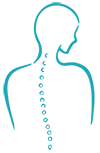Middle Back Pain
The prevalence of middle back pain (thoracic back pain) is as frequent as lower back pain or neck pain. Thoracic back pain hasn’t traditionally received the same amount of attention as lumbar and cervical pain. Therefore it remains less known to public that osteopathic treatments such as Joint Mobilization, Muscle Energy Techniques (MET), and Soft Tissue Therapy (SST) in addition to exercises, stretches, lifestyle changes and ergonomics can help to reduce pain and improve the range of motion in such cases.
Movement and rotation of spines in the middle back is more restricted than neck and lower back. This is due to the fact that in the middle back part attachment of spinal column and ribs restrict the possible range of motion of these bones. In addition, spinal conditions and abnormalities in this region is rather more pronounced and significant in comparison to lower back (lumbar) and neck (cervical) area since spinal cord and nerves in this region supply the intercostal muscles, which help inhalation and exhalation. Therefore it follows that any nerve damage or pathology of spine can cause serious effects, such as difficulty breathing, which over time can cause serious damages to visceral organs or Central Nervous System (CNS).
Thoracic back pain might happen suddenly (such as trauma, car accident, whiplash, and sport injury) or over time (such as having poor posture, repetitive movements, over bending, and over rotating). Most of the times the pain is due to soft tissue damages and it appears due to muscular irritation that might arise from lack of erector-spinae muscle power or other superficial muscle power. Degenerative joint diseases (DJD) such as osteoarthritis of the spines in vertebral column, ankylosing spondylitis are the second cause of the thoracic back pain. In this case the joint between each spine gets affected and will cause narrowing of the disc, which might cause the herniating disc, or in sever cases nerve impingement. The last cause of the thoracic back pain might be due to structural deformities and it happens rarely compare to the first two causes. Hyper kyphosis, scoliosis and Scheuermann’s disease are the conditions that essentially arise by structural deformity or osteochondroses.
Your manual osteopath can figure out the specific cause of your pain depending on your signs and symptoms after taking a complete medical history along with preliminary physical examination in your consultation session. Further treatments then follow in later session.
Osteopathic manual treatment offers many techniques to prevent and treat pain in middle back pain. Treatments aim to restore normal muscle tone in order to release of any muscle tension or nerve impingement, which in turn act towards mobilization of vertebral spines to further relieve pain. Also stretches and exercises along with certain muscle energy techniques can increase range of motion in the affected area. Almost all patients are greatly satisfied with their hands-on osteopathic treatment due to the gentle and non-intrusive nature of the treatment. Patients often report that treatment has helped to substantially reduce the frequency and intensity of their pain episodes.
Book an appointment with Nazanin Eshghi Moghaddam by calling at:
